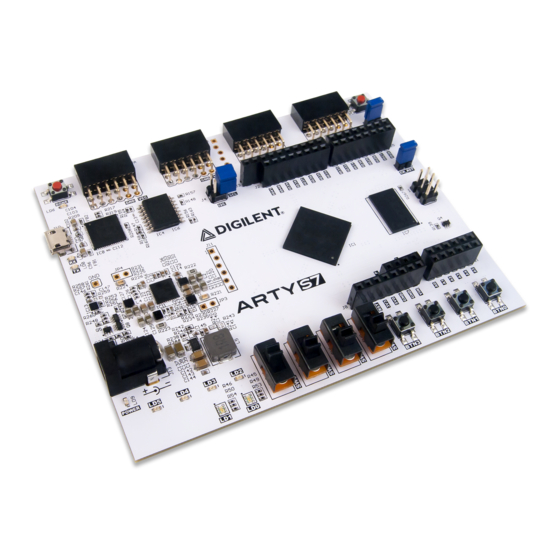Digilent Arty S7 Podręcznik referencyjny - Strona 9
Przeglądaj online lub pobierz pdf Podręcznik referencyjny dla Płyta główna Digilent Arty S7. Digilent Arty S7 14 stron.

Figure 4.1. Arty S7 SPI
(https://reference.digilentinc.com/_detail/reference/programmable-logic/arty-s7/arty-s7-flash.png?id=reference%3Aprogrammable-logic%3Aarty-s7%3Areference-manual)
flash.
5 Oscillators/Clocks
The Arty S7 board includes a 12 MHz () crystal oscillator connected to pin F14 (an MRCC input on bank 15) and a 100 MHz () crystal oscillator connected to pin R2 (an MRCC input
on bank 34).
The 12 MHz () clock is intended to be used as a general purpose system clock. The clock can drive MMCMs to generate clocks of various frequencies and with known phase
relationships that may be needed throughout a design. The 12 MHz () input clock cannot directly drive a PLL because they have a minimum input frequency of 19 MHz (). Some rules
restrict which MMCMs and PLLs may be driven by the 12 MHz () input clock. For a full description of these rules and of the capabilities of the Spartan-7 clocking resources, refer to
the "7 Series FPGAs Clocking Resources User Guide" available from Xilinx.
Xilinx offers the Clocking Wizard IP core to help users generate the different clocks required for a specific design. This wizard will properly instantiate the needed MMCMs and PLLs
based on the desired frequencies and phase relationships specified by the user. The wizard will then output an easy-to-use wrapper component around these clocking resources that can
be inserted into the user's design. The clocking wizard can be accessed from within the Vivado and IP Integrator tools.
The 100 MHz () clock is intended to drive the system clock input of the Memory Interface Generator (MIG) IP Core to allow for proper use of the DDR3L memory. Section 3
"DDR3L Memory" describes how to use this clock properly with the MIG. For complete information on using the MIG, see the 7 Series FPGAs Memory Interface Solutions User
Guide (ug586) from Xilinx.
6 USB-UART Bridge (Serial Port)
The Arty S7 includes an FTDI FT2232HQ USB-UART bridge (attached to connector J10) that allows you to use PC applications to communicate with the board using standard
Windows COM port commands. Free USB-COM port drivers, available from
www.ftdichip.com
under the "Virtual Com Port" or VCP heading, convert
(http://www.ftdichip.com)
USB packets to UART/serial port data. Serial port data is exchanged with the FPGA using a two-wire serial port (TXD/RXD). After the drivers are installed, I/O commands can be
used from the PC directed to the COM port to produce serial data traffic on the V12 and R12 FPGA pins.
Two on-board status LEDs provide visual feedback on traffic flowing through the port: the transmit LED () (LD8) and the receive LED () (LD7). Signal names that imply direction are
from the point-of-view of the DTE (Data Terminal Equipment), in this case the PC.
The FT2232HQ is also used as the controller for the Digilent USB-JTAG circuitry, but the USB-UART and USB-JTAG functions behave entirely independent of one another.
Programmers interested in using the UART functionality of the FT2232 within their design do not need to worry about the JTAG circuitry interfering with the UART data transfers,
and vice-versa. The combination of these two features into a single device allows the Arty S7 to be programmed, communicated with via UART, and powered from a computer
attached with a single Micro USB cable.
The CK_RST signal (see the Arty S7 Schematic) is also connected to the FT2232HQ device via JP2. When JP2 is shorted, the FT2232HQ can trigger a Microblaze reset, mimicking the
behavior of Arduino and chipKIT boards when sketches are loaded. Note the CK_RST signal is also connected to the red RESET button and the RST pin of J7 on the shield
connector (these connections are not shown in Figure 6.1). It is recommended that this jumper is not shorted unless attempting to run Arduino IDE on Microblaze, because it can
interfere with normal Microblaze function.
The connections between the FT2232HQ and the Spartan-7 are shown in Figure 6.1.
Figure 6.1. UART
(https://reference.digilentinc.com/_detail/reference/programmable-logic/arty-s7/arty-s7-uart.png?id=reference%3Aprogrammable-logic%3Aarty-s7%3Areference-manual)
Connections.
7 Basic I/O
The Arty S7 board includes two tri-color LEDs, 4 switches, 4 push buttons, 4 individual LEDs, and a reset button, as shown in Figure 8.1. The push buttons and slide switches are
connected to the FPGA via series resistors to prevent damage from inadvertent short circuits (a short circuit could occur if an FPGA pin assigned to a push button or slide switch was
inadvertently defined as an output). The four push buttons are "momentary" switches that normally generate a low output when they are at rest, and a high output only when they are
pressed. Slide switches generate constant high or low inputs depending on their position.
The red reset button labeled "RESET" generates a high output when at rest and a low output when pressed. The RESET button is intended to be used in Microblaze designs to reset
the processor, but you can also use it as a general purpose push button. Note that it is also tied to the RST pin on J7 of the shield connector and to the FT2232 UART device via JP2,
though these connections are not shown in the figure below.
